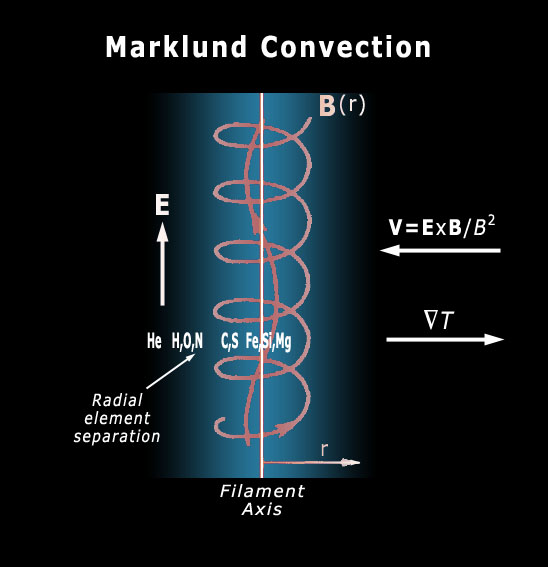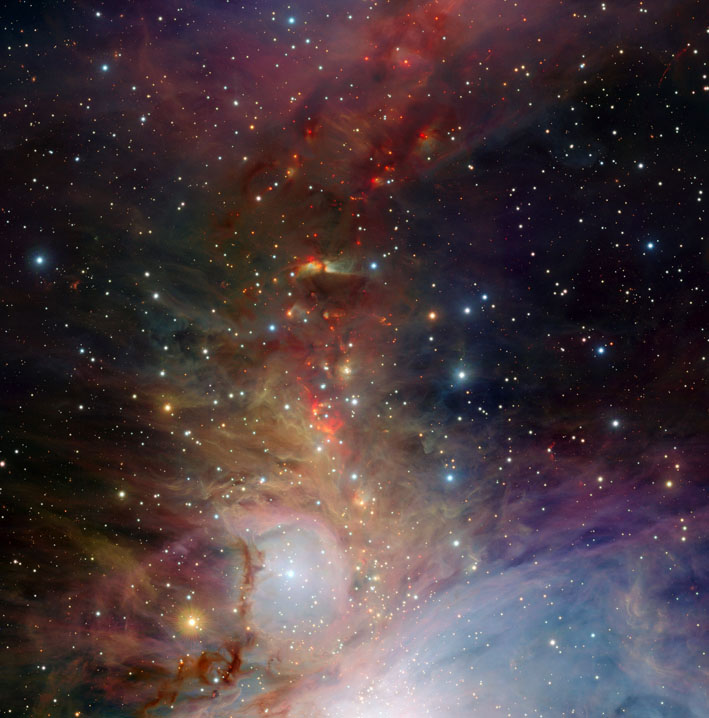Cosmic Electric Lights - 'Stars are formed following Marklund convection..' - By Wal Thornhill
Posted by ProjectC
'The electrical model of the Sun discards the problematic birth of stars by gravitational accretion. Stars are formed following Marklund convection of charged particles in dusty plasma toward the axis of galactic Birkeland current filaments.
...
There is no thermonuclear engine in stars!'
Cosmic Electric Lights
By Wal Thornhill
01 March 2010
Source
The electrical model of the Sun discards the problematic birth of stars by gravitational accretion. Stars are formed following Marklund convection of charged particles in dusty plasma toward the axis of galactic Birkeland current filaments.
<blockquote>
>> General form of the magnetic field line pattern in a force-free axisymmetric filamentary structure. The filament is transparent so the temperature decreases toward the axis due to a preferential cooling of the densest regions. So the ionized components of the plasma are convected inwards with a velocity V across a temperature gradient, delta T. Diagram adapted from Marklund, G. T., "Plasma convection in force-free magnetic fields as a mechanism for chemical separation in cosmical plasma", Nature, vol. 277, Feb. 1, 1979, p. 370, 371.
</blockquote>
It is a very efficient mechanism which results in scavenging matter with a long-range 1/r force. Marklund explains, <font color="bd934f">“In my paper in Nature the plasma convects radially inwards, with the normal E x B/B<sup>2</sup> velocity, towards the center of a cylindrical flux tube. During this convection inwards, the different chemical constituents of the plasma, each having its specific ionization potential, enter into a progressively cooler region. The plasma constituents will recombine and become neutral, and thus no longer under the influence of the electromagnetic forcing. The ionization potentials will thus determine where the different species will be deposited, or stopped in their motion."</font> Stars formed in this way have an outer envelope of helium and hydrogen. Working inwards, hydrogen, oxygen and nitrogen will form the atmospheric middle layers, and iron, silicon and magnesium will make up the core, which is cool. There is no thermonuclear engine in stars!
<blockquote>
>> This infrared image of the Orion nebula shows the new (red) stars forming along twisting current filaments in a dusty plasma. Credit: ESO/J. Emerson/VISTA & R. Gendler. Acknowledgment: Cambridge Astronomical Survey Unit.</blockquote>
Dr. Carl A. Rouse is called <font color="bd934f">“a quiet maverick of an astrophysicist whose ‘nonstandard’ models of the interior of the Sun have been provoking the solar physics community for nearly 40 years.”</font> He found from his study of pulsating variable stars that there is something wrong with the standard model of the interior of stars. Using the usual assumptions he could not match the observed mass, luminosity and radius of the Sun! He found that his model worked only by assuming the Sun has a core of heavy elements. What is more, he can reproduce the observed helioseismic oscillations. Rouse’s work deserves more attention because it fits the plasma cosmology story of star formation in a Z-pinch, with the heavy elements concentrated at the core. It also matches the Electric Universe model of electric stars, where the solar neutrino deficit is no longer “one of the greatest unsolved problems of solar physics” because sunshine is a spherical electric discharge phenomenon powered by the galaxy. It explains simply why the solar irradiance exhibits modulation identical to that of neutrinos. Nuclear reactions occur on the Sun like they do in atom smashers on Earth, by concentrating electrical energy onto a target.
<blockquote>
>> This diagram is from The Sun e-book. The simplistic estimate of the size of the body of the Sun is intended to show that the atmosphere of a star can contribute a substantial amount to its apparent size, given by the thin yellow photosphere.
...
There is no thermonuclear engine in stars!'
Cosmic Electric Lights
By Wal Thornhill
01 March 2010
Source
The electrical model of the Sun discards the problematic birth of stars by gravitational accretion. Stars are formed following Marklund convection of charged particles in dusty plasma toward the axis of galactic Birkeland current filaments.
<blockquote>

>> General form of the magnetic field line pattern in a force-free axisymmetric filamentary structure. The filament is transparent so the temperature decreases toward the axis due to a preferential cooling of the densest regions. So the ionized components of the plasma are convected inwards with a velocity V across a temperature gradient, delta T. Diagram adapted from Marklund, G. T., "Plasma convection in force-free magnetic fields as a mechanism for chemical separation in cosmical plasma", Nature, vol. 277, Feb. 1, 1979, p. 370, 371.
</blockquote>
It is a very efficient mechanism which results in scavenging matter with a long-range 1/r force. Marklund explains, <font color="bd934f">“In my paper in Nature the plasma convects radially inwards, with the normal E x B/B<sup>2</sup> velocity, towards the center of a cylindrical flux tube. During this convection inwards, the different chemical constituents of the plasma, each having its specific ionization potential, enter into a progressively cooler region. The plasma constituents will recombine and become neutral, and thus no longer under the influence of the electromagnetic forcing. The ionization potentials will thus determine where the different species will be deposited, or stopped in their motion."</font> Stars formed in this way have an outer envelope of helium and hydrogen. Working inwards, hydrogen, oxygen and nitrogen will form the atmospheric middle layers, and iron, silicon and magnesium will make up the core, which is cool. There is no thermonuclear engine in stars!
<blockquote>

>> This infrared image of the Orion nebula shows the new (red) stars forming along twisting current filaments in a dusty plasma. Credit: ESO/J. Emerson/VISTA & R. Gendler. Acknowledgment: Cambridge Astronomical Survey Unit.</blockquote>
Dr. Carl A. Rouse is called <font color="bd934f">“a quiet maverick of an astrophysicist whose ‘nonstandard’ models of the interior of the Sun have been provoking the solar physics community for nearly 40 years.”</font> He found from his study of pulsating variable stars that there is something wrong with the standard model of the interior of stars. Using the usual assumptions he could not match the observed mass, luminosity and radius of the Sun! He found that his model worked only by assuming the Sun has a core of heavy elements. What is more, he can reproduce the observed helioseismic oscillations. Rouse’s work deserves more attention because it fits the plasma cosmology story of star formation in a Z-pinch, with the heavy elements concentrated at the core. It also matches the Electric Universe model of electric stars, where the solar neutrino deficit is no longer “one of the greatest unsolved problems of solar physics” because sunshine is a spherical electric discharge phenomenon powered by the galaxy. It explains simply why the solar irradiance exhibits modulation identical to that of neutrinos. Nuclear reactions occur on the Sun like they do in atom smashers on Earth, by concentrating electrical energy onto a target.
<blockquote>

>> This diagram is from The Sun e-book. The simplistic estimate of the size of the body of the Sun is intended to show that the atmosphere of a star can contribute a substantial amount to its apparent size, given by the thin yellow photosphere.